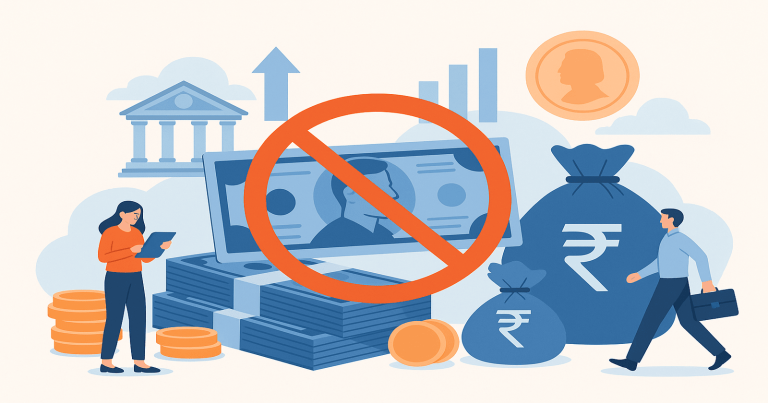Money plays a big role in our daily life. We use it to buy food, clothes, pay bills, and more. But sometimes, the government takes a big step that changes the way we use money. One such major step is demonetization. It can affect everything—from how we shop to how businesses work. People may suddenly find the cash in their pocket useless, and banks become crowded with people trying to exchange their money.
What is Demonetization?
Demonetization means the act of removing a currency note’s legal value. It happens when a government declares that certain notes will no longer be valid for use in the economy. So, what is demonetization? It is when old currency notes or coins stop being accepted for payments, and people must exchange them for new ones. Governments take this step for various reasons such as fighting black money, stopping fake currency, or modernizing the financial system.
India’s most popular example of demonetization happened on 8 November 2016. On that day, the Prime Minister of India announced that ₹500 and ₹1000 notes would no longer be legal. These notes made up almost 86% of the cash in circulation. People had to deposit their old notes in banks or exchange them for new notes. The aim was to stop illegal money, push digital payments, and catch tax evaders.

What are the Reasons Behind Demonetization?
Demonetization is not a random step. Governments do it with a plan. There are strong reasons behind demonetization that relate to a country’s economy and safety.Demonetization doesn’t happen without purpose. Governments take this bold step to tackle some major problems in the economy. These reasons connect directly to people’s lives and the country’s future.
Stop Black Money
Many people hide their money to avoid paying taxes. This money is called black money. They keep it in cash, often in high-value notes. When demonetization happens, they cannot easily exchange large amounts without showing income proof. This makes black money useless.
Curb Fake Currency
Fake currency is a big danger. It weakens the economy and helps criminals. If high-value notes are demonetized, fake currency becomes useless. It stops those printing fake notes from causing harm.
Fight Corruption
Corruption increases when people take bribes in cash. By removing big notes, corrupt activities become harder. People will avoid keeping too much cash at home. It pushes more people to use banking channels.
Push Digital Payments
When cash is less, people start using digital ways to pay. UPI, debit cards, net banking become popular. It helps create a cleaner economy where every transaction is recorded.
Control Inflation
In some cases, demonetization helps control inflation. When cash supply is reduced suddenly, prices may go down. People spend less, which reduces demand, and helps in price control.
Modernize the Economy
Countries like India are moving toward digital, transparent economies. Demonetization supports this goal by encouraging cashless systems and formal business activities.
How Does Demonetization Work?
Demonetization is a big decision. It needs careful planning and steps.The process of demonetization is not simple. It needs a lot of planning and quick action. This section explains how the government carries out demonetization and manages the flow of currency. Here’s how it usually happens:
Official Announcement
The government makes a surprise announcement. It tells the public which notes will no longer be valid. The decision is usually sudden to stop black money holders from getting time to convert it.
Time Limit for Exchange
People get a fixed time to deposit old notes in their bank accounts. In India’s case in 2016, the public got time till December 30 to exchange notes.
Issue of New Currency
The Reserve Bank of India (RBI) or the central bank starts printing and releasing new currency notes. These replace the old ones. In 2016, new ₹500 and ₹2000 notes were issued.
Set Daily Limits
To control the crowd at banks and ATMs, the government sets limits. People can only withdraw or exchange a certain amount each day.
Monitor Large Deposits
The government keeps a watch on big cash deposits. If someone deposits a large amount without valid income, they may face tax penalties.
Promote Online Payments
Banks and the government promote UPI, mobile wallets, and debit cards. People are encouraged to go cashless.
Impact of Demonetization on Indian Economy
Demonetization affects every corner of the economy. From banks and businesses to common people, all feel the change. Let’s explore how India’s economy reacted in both short and long terms.
Short-Term Impact
- Cash Shortage: ATMs ran out of cash. Long queues formed outside banks.
- Loss of Jobs: Daily wage workers and small traders lost income.
- Slow Business: Many shops and markets saw fewer buyers.
- School and Travel Issues: People could not pay school fees or book tickets.
- Medical Problems: Some patients could not buy medicines due to cash issues.
Long-Term Impact
- More Taxpayers: Many people who never paid tax came into the system.
- Higher Digital Use: UPI, Paytm, and other apps grew fast.
- Better Banking: More people opened bank accounts.
- Growth in Formal Economy: Small businesses started using digital ways.
- Fall in Fake Notes: Counterfeit currency reduced.
Benefits of Demonetization
Even though it caused short-term trouble, demonetization brought many long-term gains. It helped clean up parts of the system and introduced positive changes in money usage and tax collection.Many benefits came from demonetization. Let’s look at them in detail:
Control on Black Money
People who hid their income in cash had to bring it into banks. They feared penalty and scrutiny. Many chose to leave the money. This helped reduce black money circulation.
Rise in Digital Economy
India saw a jump in UPI usage. Mobile apps like Google Pay, PhonePe, and Paytm became common. Even roadside vendors began accepting digital money.
Higher Tax Compliance
People feared investigation, so they started filing taxes. The number of taxpayers increased. It helped the government collect more money.
Formalization of Business
Small businesses earlier ran on cash only. Post demonetization, they started using bank transactions. This made them part of the formal economy.
Better Data for Policymaking
With more people using digital payments, the government could track money flow. It helped create better policies for subsidies, welfare, and tax reform.
Disadvantages of Demonetization
Demonetization also had several drawbacks. Many people suffered due to the sudden cash crunch. This section highlights the struggles and challenges faced by citizens, especially the poor and small businesses. Let’s look at the main disadvantages.
Loss of Jobs
Daily workers, especially in construction and textile, lost jobs. Employers did not have enough cash to pay wages.
Fall in GDP
India’s GDP growth slowed for some time. Businesses faced losses. People avoided spending.
Impact on Rural Economy
Villages use more cash than cities. People had to travel far to find banks or ATMs. Farmers could not buy seeds or sell produce easily.
Health and Emergency Issues
Hospitals and pharmacies refused old notes in many cases. Some patients could not get timely treatment.
Unplanned Execution
ATMs did not have enough new notes. People stood in lines for hours. Some even died due to stress and delay.
Global Examples of Demonetization
India is not the only country that went through demonetization. Other nations have also taken similar steps for various reasons. Let’s see how those events turned out across the world. Many others have done it too.
Zimbabwe
In 2015, Zimbabwe dropped its currency due to inflation. It adopted the US dollar instead.
Nigeria
In 2022-23, Nigeria also demonetized high-value notes to stop hoarding and corruption. It faced similar issues like India, such as cash shortage and economic slowdown.
Soviet Union
In 1991, the USSR removed high denomination ruble notes to stop illegal wealth. It caused major unrest.
Future of Currency and Digital Economy
Demonetization gave a big push to digital money. It changed how people handle payments and savings. Here, we look at how it opened the door to a more modern and digital financial future.
Growth of Digital Payments
UPI payments now cross billions daily. People pay school fees, bills, groceries, and even donations digitally.
Rise of Fintech Companies
Startups in the financial space grew fast. They offer loans, wallets, investments, and even insurance.
Better Transparency
The government now tracks more money. It leads to less corruption and better planning.
More Financial Literacy
People now understand banking, saving, and digital tools better. Students and adults both have become more aware.
What is Demonetisation FAQs
What is demonetisation in India?
Demonetisation in India refers to the government’s decision in 2016 to invalidate ₹500 and ₹1,000 currency notes.
What is the purpose of demonetisation?
The primary purpose of demonetisation is to reduce black money, counterfeit currency, and corruption. Promoting a shift to digital transactions and increasing tax compliance.
What were the effects of demonetisation on small businesses?
Demonetisation severely affected small businesses because they heavily relied on cash transactions. Many businesses suffered losses and had to either shut down or switch to digital payment methods.
Did demonetisation reduce black money?
Demonetisation helped bring some black money into the formal banking system, but it did not completely eradicate black money. Many individuals found ways to convert or launder illicit funds.
What are the disadvantages of demonetisation?
The main disadvantages of demonetisation include short-term economic disruptions, job losses, and limited effect on eradicating black money.


